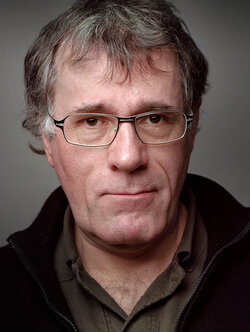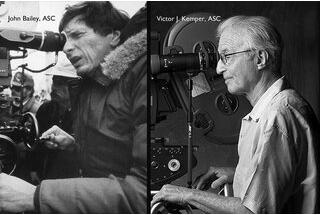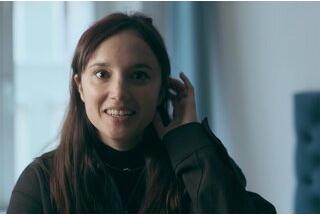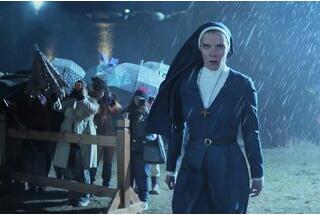Too Many Labs Out of Control
By DoP Philippe Ros, AFC, Imago Technical Committee MemberSpecial thanks to Irena Gruca who gave authorization to AFC to publish this article released in “Intermediate” european magazine launched by CineArte (Germany) & FilmPro (Poland).
This article has received some more inputs after the last Camerimage and the Micro Salon 2012.
I’ve been invited to organize and participate in a panel discussion of famous directors, DPs and editors at the upcoming eDIT 14. Filmmaker’s Festival. Among the guests are Imago President Nigel Walters, BSC, Bary Ackroyd, BSC, Richard Andry, AFC, Simon Walker colorist, Jan Schütte, director and DFFB manager and Peter Zeitlinger, BVK. The topic of the discussion was the role of DPs in the Digital Intermediate.
The big question is, are we still controlling the image and the final release?
Consider the dramatic changes that happened merely over the last 10 years. The complexity of the digital intermediate (DI) and the complexity of digital cameras (let’s take as example the role of the Bayer pattern) lead a lot of DoPs to withdraw from the technical debate. Some DoPs aren’t even invited anymore to choose the right format, adequate cameras or even to follow the grading process.
Some trendy stances could let directors or producers think that a 2K di can be done on a laptop.
In this article, I will try to sum up some of the main issues and characterize the way of thinking that led to those issues.
Sometimes, the best way to preset a process is to draw a diagram. In the following diagrams, one of the most important symbols is the black-and-white lab picture.
Why black-and-white? Nostalgia aside, we want to be sure that the symbol is efficient.
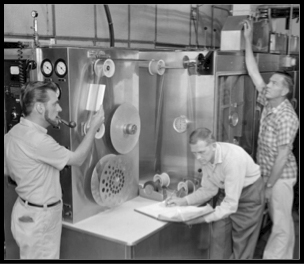
One single laboratory or several laboratories?
Before DI the process was simple. You shot, and in case of specific demands you just changed some parameters in the neg process or the print – bleach by pass, bath temperature. DoPs didn’t have a large range of possibilities.
But there was and there still is a standard describing how to process a neg. Let’s have a look at the process visualized as the red line on the diagram.

When DI enters the scene, a lot of new opportunities arise but also some troubles start to occur.
No longer a clearly defined line, the process is more of a wide open space with no standards and a lot of difficulties. There are new technologies, there is even bigger importance of the colorist, and brand new levels of know-how on the post facilities.
There are many interesting challenges but all too often the process seems like running down a dark corridor strewn with rakes scattered on the floor.

If we take into account the new importance of grading, the diagram hardly represents
the possibilities. Let’s face it: a new lab was born. Even if now we realize that a 2K DI cannot capture all the richness of a neg, it would be a little bit snobbish not to recognize the pleasure of working in a grading suite.

Most of the issues come from the lack of standard procedures during the digital intermediate. That is why we marked the new lab with red rectangles symbolizing “wild territories”.
Let’s stay positive and assume for now that the dcp and the print lab follow standard process. But be aware that the red rectangle above can easily include all the labs – symbolizing the floating parameters of scan and film recording, that you can encounter in your di travel if you are unfortunate.
For those interested in a more focused approach, i strongly recommend an interview
with Pawel Edelman (firstly published in Filmpro magazine – editors note) on Imago website.
His experiences clearly show all the issues that DoPs are currently facing.
My personal philosophy is to follow good technicians and artists. Follow the right person you will have the right technology. That’s why I’m giving a lot of consideration to my colorist. He’s is at the key point of the process and with a right approach to the technology he can and increase the quality of the di. His experience on digital cameras is incredibly valuable.
To speak about a digital camera you just have to see the results of the tests on a large screen in a grading suite. in a way the colorist is part of a control tower leading the DI. I can’t imagine choosing a new film stocks or a digital camera without my colorist.
I always feel sceptical when I’m reading articles describing digital cameras like solutions to all movie industry issues without mentioning reactions of the DPs and colorist in the grading suite.
VFX supervisors are always surprised when camera manufactures provide no informations on keying, no informations on the codecs.
Glorify a camera which is just a part of the workflow seems to be quite dangerous.

Digital shooting adds a whole new dimension to the process. We can easily say that every camera is a lab on its own, with a different set of controls.
We can encounter both very sophisticated internal menus like the one in the F35 and very simple and efficient ones like the menu in Alexa. Personally I follow one rule: to prepare the architecture of the camera before shooting and to use the minimum of settings on set. We must realize that different types of camera sensors change some aspects of the process. Knowing the space colour of the camera, its different codecs becomes essential.
I don’t understand when camera manufactures don’t provide any informations on these key points.
The Bayer Filter
Things were very simple before the Bayer filter become so popular.
In the Bayer filter which is fitted in front of the mono sensor. Green pixels follow a mosaic pattern, red and blue ones are arranged on a square grid. there are twice as many green sensors as red and blue ones. Human eyes are more sensitive to luminance than to chrominance. Green is the key-color. Manufacturing mono sensors using Bayer pattern is less expensive than manufacturing striped mono sensor like in the Sony F35 or in the panavision Genesis or using yet another approach, that is three chips sensors like those in the Sony F900 / F23 cameras.
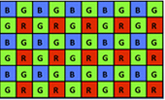


At the end, the post will need an RGB image, so for footage from cameras using a Bayer pattern a mathematic process must be run to recalculate the missing informations from the red and blue channels. once again, i do consider that part as a kind of a “lab process”.
To make things more complicated, the place of the debayering process in the workflow is a very important matter.
Depending on the means and circumstances of a particular production, the debayering process would be set in different places, and for most of the time the collateral damage of this decision would be totally ignored.
Look at the charts to see different approaches to debayering data on the Red One / MX cameras.
The debayering process – Red cameras
Look at the charts to see different approaches to debayering data on the Red One / MX
cameras.



Depending on the quality of debayering and its place in the process you can receive
totally different Red one / MX outcome images.
The last solution, debayering included in the grading phase, provides more flexibility to the colourist but, because it can slow down all the process, the costs can be higher. This debayering phase is so important that a point of view on a camera using the Bayer filter depends on the know-how of the lab.
Saying that an Epic camera is better than an Alexa or saying the opposite depends totally on the way the software used by the lab has ‘’revealed’’ the raw images.
One lab will have more experience on a camera than another.
Will the lab technicians have the opportunity to meet the good softwares able to provide a good colour reproduction, a correct control of the sharpness? It will depend on their availabilities and if the lab has understood that a R & D department is necessary.
Tips are exchanged far away from the rigorous method of the chemical negative process.
It’s the gifted but confusing world of mathematics and geeks. Lab technicians become new Beta testers like DPs, DITs and 1st Acs.
Does it mean that these cameras are bad? I would say no, there are no bad cameras, there are just bad choices and misunderstandings of process.
The marketing phase, new king of the movie industry
Regarding the introduction of the Red cameras on the market, the Red One represent an interesting symbol. You have to understand all the parameters which define this camera.
If you know the price, and accept that a certain amount of artifacts is inevitable, the trade-off can be acceptable. And it would be unwise not to recognize that a lot of indie movies have been possible only thanks to these cameras.
But what are the real costs of the operation? that’s the point.
Before the arrival of the MX, i wasn’t really against the machine but against the marketing – smart for sure but based on lies. Where was the 11 stops latitude? Were was the 500 ISO rating? Where was the (true) 4K resolution? Where was the filmic approach to the skin tone?
We definitivly missed an occasion to set the record straight.
The other downside of the Bayer filter is the real time debayering that every camera must provide to the viewfinder and the monitoring. There is a big difference between the reliable output provided by the Alexa and the “just for framing” output of the original Red One. The Epic is fortunately providing better images in the viewfinders and for the monitoring.
Bayer filter seemed to have reach its maturity with the Alexa, certainly because of the historical position of Arri in the movie world. As for now, using this type of camera is easy and reliable, and above all, you can match several of those cameras without encountering different “labs”.
Approximative datas are still spread, example: the Red Epic even with it’s 5K output is far away of providing a 5K resolution as well as the Red One never gave a 4K resolution. Manufacturers marketing is surfing on confusion between photosites and pixels. Is it a big issue.
No, if you know the limitations of the tool you can use the advantages of the small size of the Epic and obtain good images.
The other issue of the Bayer pattern comes from the need to get a real time debayering for the viewfinder and the monitoring. There’s a huge difference between the HDSDI outputs of the Alexa and the Red One/ MX.
First one is reliable, second one can’t give more than a possibility to check the framing.
Forget having an idea of the light and the final image on Red One /MX monitorings. But the difference of prices between both cameras is one of the reason of such technical gaps. Fortunatly the viewfinder and outputs of the Epic camera have been seriously improved by the manufacturer.
The evolution of digital cameras
Cameras using Bayer filter have reached maturity with the Alexa certainly because of the film experience of Arri. Working with these cameras become easier and in case of multi-camera shooting, the different ‘’internal labs’’ of the cameras can be quickly harmonized.
The stunning images of the Aaton Delta screened at the Micro Salon have shown another side of the coin of the Bayer filter cameras: the type of sensor. The CCD sensor allied with an efficient research give the image a diferent look than the
CMOS.
As well as we’ve been speaking about a film stock texture, we will now speak about different digital textures, different colour renderings. If you add the extreme sharpness of the Sony F65, it’s clear that DPs have now a larger range of possibilities.
One important improvement is the optical viewfinder of the Arri Alexa Studio and of the Aaton Delta which will give camera operators their former role of first spectator. They have lost this power with the electronical viewfinders. I don’t think we realize now the importance of this event in the control of the image.
Once again, the goal it is not to establish distinction between good and bad cameras, but between means and possibilities, and to point out the fallout of marketing process.
Control of the workflow
Let’s go back to the main purpose of this article and look at the diagrams above. Every red rectangle marks a moment in the process requiring human or technological inputs. The problems arise when nobody is really in charge of those different “labs” or when someone operating the machines does not really understand all the stages of the process and their effects.
How to retain control over the image when there are several different “labs” on the
line of the workflow? With the very efficient Log curves provided by Arri or sony, how to deal with Luts? For me, that’s a decisive point.
We know that the logarithmic curves are providing the best capture of information for the dynamic range on set and do considerably enhance the possibilities in post. I see no reasons to use other curves, even for TV releases.
The image provided by such curves has a low level of contrast and saturation of color and needs to be corrected for monitoring and editing. That’s one part of the role of LUTs.


And yet, at least in France, some DoPs are still using REC 709 curves, wanting to
avoid loosing control over the process. They do this because within their workflow
the correction of these dull images is not efficient.
That is a very significant point, because the idea that everything will be revealed in post can become a trap – at least if there’s no control over the process. And unfortunately that is still the case with those postproduction studios, which have not invested in the LUTs field.
There’s a serious matter for DoP’s to show flat logarithmic images images without any
correction or any control to directors, producers, broadcasters. It can become a serous
matter for producers themeselves.
Nothing is worse during editing for a director to be accustomed to an image not related to the stage choices. When he will enter the grading suite, he will be shocked by the correct image because his brain has automatically proceeded to adjustments during editing.
I believe that we DoPs must be involved in the process from the very beginning: from the creation and control to the delivery of the LUTs. I am not alone in this belief as many others dops have already acknowledged the key role of LUTs.
Now, let’s focus on the set. What will the director and the editor see in the editing room?
The look created on set by directors and DoPs must be respected through the whole workflow. That is crucial if we, DoPs want to achieve not only an image but also maintain a consistent role in the DI. Many manufacturers (Arri, Aaton, Red, Pomfort, etc.) have already put an emphasis on the control of the Luts. they all realize that what is at stake has a great importance.
It is an oversimplification to talk about dops being pushed out from the di without admitting to our own responsibility. I think that we failed to launch a right criticism to several technologies because we were not involved enough in the process and not conscious of all the aspects of the situation.
France is suffering a lot from this withdrawal stance. We failed to give way to technology at the right moment. There is a strange separation that you can feel among DoPs in France: the geeks vs the artists. For some, IBC is not a place for a DoP should go to. Unfortunately being above the “dirty” market created a void.
On websites, you can read many articles where strange specialists describe digital cameras without never having had any field experience. Ergonomics, practicabilty are never mentioned as well as grading is totally forgotten.
This behaviour help marketing to launch half thruths and real lies. Confusion between photosites and pixels. That attitude helped marketing half-truths and lies establish an undeserved yet strong position in the DoPs’ world. We still can see the confusion between actual resolution and the number of pixels making a lot of damages when cameras are chosen and post-production workflow is established.
This is not the number of pixels which give an image its beauty, this is the quality and the treatment of these pixels. Images from Delta and Alexa anamorphic are there to remind us this fact.
One of the problem of the web information: your mission if you accept is to find in 5 minutes, reliable datas on quality of digital cameras when you have to key on a green screen. I never succeeded in getting a quick answer.
It is obvious that only historical manufacturers like Aaton, Arri and Panavision are the one to speak about key controls when they are presenting their new cameras.
There is one more factor explaining the confusion we are facing – is the clash of two different worlds: the professionals versus the consumers. All DSLR tools used to make commercials, feature films or even TV movies are there to remind us, that the border doesn’t exist anymore.
The effects are both good and perverse and their full extent cannot be analyzed in a short paragraph. For those interested I recommend the funny and clever point of view of Jon Fauer presented on first pages of Film & Digital Times Issues 36-38.
Finally I want to point out, that currently we look at digital cameras from an engineer’s point of view. Usually we want to see on screen exactly the same, what traditional film has provided us for years. I think that we must allow ourselves to look at digital cameras and DI with more freedom and try to walk on the “wild side”.
Nevertheless, theres are some signs of hope, the panle during the eDIT 14 Filmmaker’s festival is one of the proofs, that the generake awareness in the film industry regarding these problems is growing.
Note: I recommend the excellent tutorial covering this topic, by Dr Hans Kiening: 4K+ systems - theory Basics for Motion picture imaging.
(Phlippe Ros is Director of Photography, member of AFC and Imago Technical Committee)
 En
En
 Fr
Fr